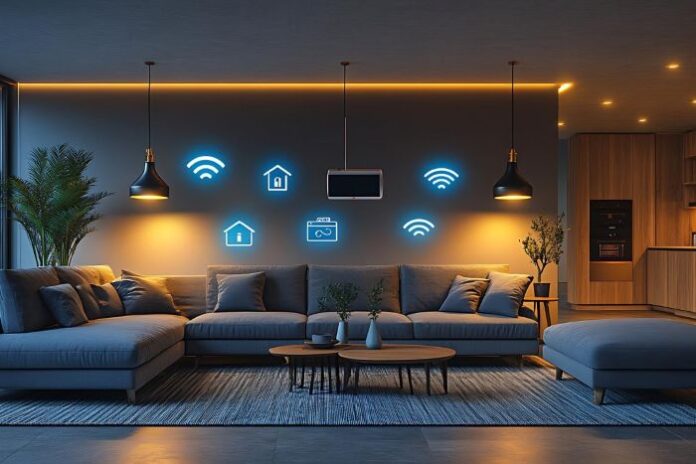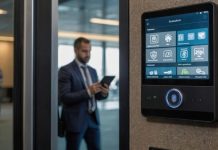Smart homes are no longer a futuristic fantasy. Today, the idea of controlling lighting, thermostats, appliances, and even security systems from your phone or voice assistant has become a practical reality. As technology continues to evolve, so does the concept of the connected home. At the core of this transformation lies smart connectivity—a network of devices that communicate seamlessly. This creates environments that aren’t only more efficient but also more personalized and intuitive.
Key Takeaways
- Smart homes have gained popularity, enabling control of devices via phones and voice assistants.
- Smart connectivity enhances efficiency and security by enabling smart devices to learn user routines and automate tasks.
- Integration via smart hubs enables different devices to work together seamlessly, enhancing functionality.
- Reliable connectivity, primarily via mesh networks, is crucial to the smooth operation of smart home ecosystems.
- Future trends include AI-driven automation, interoperability standards, and health monitoring technologies.
Table of Contents
The Rise of the Smart Home
Over the past decade, smart home technology has shifted from a luxury to a mainstream category. Early adopters once needed deep pockets to afford even basic automation tools. Now, smart light bulbs, video doorbells, and voice-activated assistants are available at every major electronics store. They are easily integrated into existing home setups.
Several trends have fueled this growing accessibility. First, the widespread adoption of smartphones and tablets has given homeowners the tools to control their environments from anywhere. Second, cloud computing has enabled devices to store and process vast amounts of data off-site. This makes them lighter and more responsive. Finally, artificial intelligence (AI) and machine learning have enabled smart devices to “learn” users’ routines, automatically adjusting their behavior to match preferences.
Beyond Convenience: Efficiency and Security
Smart connectivity goes beyond simple convenience—it brings energy efficiency and enhanced security to the forefront. Smart thermostats like Nest and Ecobee adapt to a household’s schedule, reducing energy waste and saving money. Additionally, smart plugs and appliances automatically turn off when not in use or during peak energy demand. Over time, this not only lowers utility bills but also contributes to a more sustainable lifestyle.
On the security side, smart door locks, motion detectors, and surveillance systems provide real-time alerts and live video feeds. These devices can differentiate between routine activity and potential threats. They alert homeowners and authorities instantly. In fact, smart security systems can often be monitored from anywhere in the world. Therefore, users have peace of mind whether they’re at the office or on vacation.
Seamless Integration Through Smart Hubs
As more devices enter our homes, the need for seamless integration becomes increasingly important. Smart hubs like Amazon Echo, Google Nest Hub, and Apple HomePod help tie disparate technologies together. They do this under a unified control system. These hubs act as translators, enabling devices from different brands to work together. They respond to voice commands or scheduled tasks.
This integration also supports scenarios where multiple devices work together. For example, when a smart doorbell detects motion, it can trigger bright lights to turn on. It can also notify the user via their phone—all without human intervention. This kind of “scene-based automation” represents the next level of smart home functionality.
The Critical Role of Reliable Connectivity
While devices and hubs form the brain of a smart home, they can only function as well as the network that connects them. Inconsistent Wi-Fi can lead to delays, disconnections, and frustration. That’s where a mesh system becomes vital. Unlike traditional routers, mesh systems use multiple access points to distribute the signal throughout a home evenly. This eliminates dead zones and ensures every connected device receives stable, high-speed internet. Reliable performance is essential for maintaining increasingly complex smart home ecosystems, and in situations where power or wiring failures disrupt connectivity, finding quick emergency electrical repair can help restore safe and continuous operation.
Future Trends in Smart Living
As smart homes continue to evolve, several innovations are on the horizon that will redefine what it means to live in a connected environment.
- AI-Driven Automation: Devices will increasingly make decisions independently. For example, adjusting lighting based on natural sunlight or preheating the oven when you leave the grocery store.
- Interoperability Standards: Efforts like Matter—a unified connectivity standard backed by major tech companies—aim to resolve compatibility issues. This makes setup easier for consumers.
- Health and Wellness Monitoring: Smart homes are moving toward proactively supporting health, with devices that monitor air quality. They also detect water leaks and even track vital signs or sleep quality.
- Voice as the Primary Interface: As voice assistants improve, natural language processing will enable more nuanced and complex interactions between users and their devices.
Final Thoughts
Tech-savvy homes are no longer about isolated gadgets. They’re about creating connected ecosystems that enhance comfort, security, and efficiency. From lighting controls to smart ceiling fan rotation direction, every detail contributes to maintaining the perfect environment. As smart connectivity continues to improve, we can expect homes to become even more responsive to our needs, operating quietly in the background to simplify daily life.
The key to unlocking this potential lies in building a solid foundation. This foundation includes reliable connectivity, intuitive automation, and interoperability across devices. For homeowners looking to embrace the future, the time to start is now.











